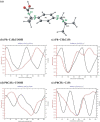Molecular Dynamics and Physical Stability of Ibuprofen in Binary Mixtures with an Acetylated Derivative of Maltose
- PMID: 32584584
- PMCID: PMC7467776
- DOI: 10.1021/acs.molpharmaceut.0c00517
Molecular Dynamics and Physical Stability of Ibuprofen in Binary Mixtures with an Acetylated Derivative of Maltose
Abstract
In this paper, we explore the strategy increasingly used to improve the bioavailability of poorly water-soluble crystalline drugs by formulating their amorphous solid dispersions. We focus on the potential application of a low molecular weight excipient octaacetyl-maltose (acMAL) to prepare physically stable amorphous solid dispersions with ibuprofen (IBU) aimed at enhancing water solubility of the drug compared to that of its crystalline counterpart. We thoroughly investigate global and local molecular dynamics, thermal properties, and physical stability of the IBU+acMAL binary systems by using broadband dielectric spectroscopy and differential scanning calorimetry as well as test their water solubility and dissolution rate. The obtained results are extensively discussed by analyzing several factors considered to affect the physical stability of amorphous systems, including those related to the global mobility, such as plasticization/antiplasticization effects, the activation energy, fragility parameter, and the number of dynamically correlated molecules as well as specific intermolecular interactions like hydrogen bonds, supporting the latter by density functional theory calculations. The observations made for the IBU+acMAL binary systems and drawn recommendations give a better insight into our understanding of molecular mechanisms governing the physical stability of amorphous solid dispersions.
Keywords: amorphous drug; amorphous solid dispersion; crystallization; devitrification; glass transition; ibuprofen; molecular dynamics; physical stability.
Conflict of interest statement
The authors declare no competing financial interest.
Figures















Similar articles
-
Molecular Factors Governing the Liquid and Glassy States Recrystallization of Celecoxib in Binary Mixtures with Excipients of Different Molecular Weights.Mol Pharm. 2017 Apr 3;14(4):1154-1168. doi: 10.1021/acs.molpharmaceut.6b01056. Epub 2017 Mar 8. Mol Pharm. 2017. PMID: 28241116
-
Enhancement of the physical stability of amorphous indomethacin by mixing it with octaacetylmaltose. inter and intra molecular studies.Pharm Res. 2014 Oct;31(10):2887-903. doi: 10.1007/s11095-014-1385-4. Epub 2014 May 15. Pharm Res. 2014. PMID: 24831310
-
Glass Transition Dynamics and Physical Stability of Amorphous Griseofulvin in Binary Mixtures with Low-Tg Excipients.Mol Pharm. 2019 Aug 5;16(8):3626-3635. doi: 10.1021/acs.molpharmaceut.9b00476. Epub 2019 Jul 23. Mol Pharm. 2019. PMID: 31287704
-
What Are the Important Factors That Influence API Crystallization in Miscible Amorphous API-Excipient Mixtures during Long-Term Storage in the Glassy State?Mol Pharm. 2022 Feb 7;19(2):378-391. doi: 10.1021/acs.molpharmaceut.1c00519. Epub 2021 Aug 11. Mol Pharm. 2022. PMID: 34378939 Review.
-
Classification of solid dispersions: correlation to (i) stability and solubility (ii) preparation and characterization techniques.Drug Dev Ind Pharm. 2015;41(9):1401-15. doi: 10.3109/03639045.2015.1018274. Epub 2015 May 20. Drug Dev Ind Pharm. 2015. PMID: 25853292 Review.
Cited by
-
Structure and Glass Transition Temperature of Amorphous Dispersions of Model Pharmaceuticals with Nucleobases from Molecular Dynamics.Pharmaceutics. 2021 Aug 13;13(8):1253. doi: 10.3390/pharmaceutics13081253. Pharmaceutics. 2021. PMID: 34452214 Free PMC article.
-
Hydrophilic and Amphiphilic Macromolecules as Modulators of the Physical Stability and Bioavailability of Piribedil: A Study on Binary Mixtures and Micellar Systems.Mol Pharm. 2025 Aug 4;22(8):4708-4730. doi: 10.1021/acs.molpharmaceut.5c00276. Epub 2025 Jun 30. Mol Pharm. 2025. PMID: 40586556 Free PMC article.
-
Comparison of Two Synthesis Methods for 3D PLA-Ibuprofen Nanofibrillar Scaffolds.Pharmaceutics. 2025 Jan 14;17(1):106. doi: 10.3390/pharmaceutics17010106. Pharmaceutics. 2025. PMID: 39861754 Free PMC article.
-
Study of Thermal Properties, Molecular Dynamics, and Physical Stability of Etoricoxib Mixtures with Octaacetylmaltose near the Glass Transition.Int J Mol Sci. 2022 Aug 29;23(17):9794. doi: 10.3390/ijms23179794. Int J Mol Sci. 2022. PMID: 36077212 Free PMC article.
-
Fragility and Tendency to Crystallization for Structurally Related Compounds.Int J Mol Sci. 2024 Mar 11;25(6):3200. doi: 10.3390/ijms25063200. Int J Mol Sci. 2024. PMID: 38542174 Free PMC article.
References
-
- Patel R.; Patel N.; Patel N. M. A novel approach for dissolution enhancement of Ibuprofen by preparing floating granules. Int. J. Res. Pharm. Sci. 2010, 1, 57–64.
Publication types
MeSH terms
Substances
LinkOut - more resources
Full Text Sources

